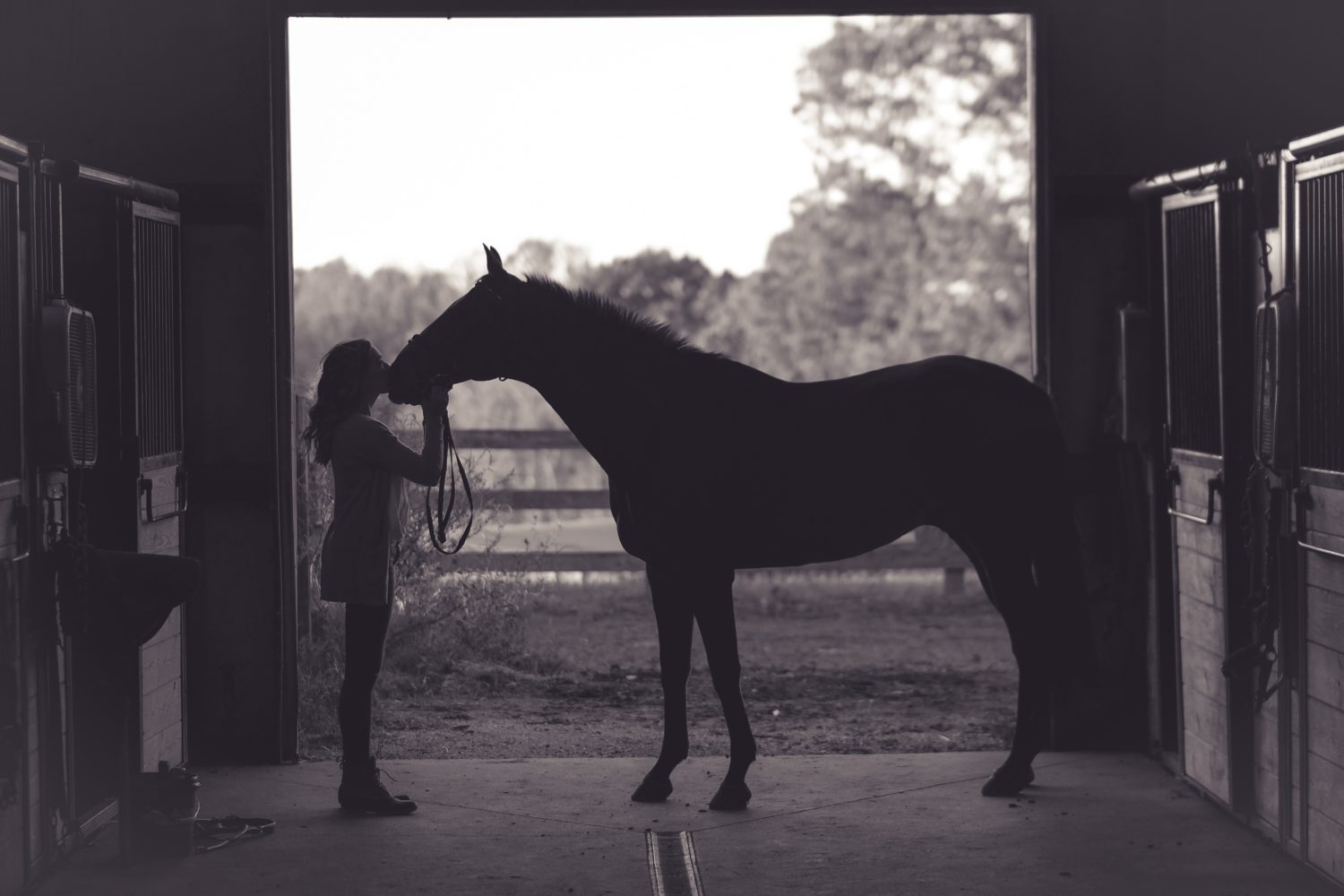It sucks being injured. You’ll get no argument from me on that front.
But possibly worse than any injury itself are those days, weeks or maybe even months that you feel helpless and useless. And sadly there’s no quick or easy fix for those feelings other than to take the appropriate amount of time that your body needs to heal.
For me having to put training and riding on hold is incredibly difficult, just as I’m sure it is for any other person whose schedule revolves somewhat around their horses. With an injury to my foot I’m still somewhat mobile but nowhere near ready to climb in the saddle.
Which has left me thinking… what the hell can I do other than read books and watch competitions while I’m on the injured list?
The answer is quite a bit actually! From some ground exercises to just chilling with your fur baby, here are 7 easy things you can do while you’re injured but semi-mobile.
Obviously PLEASE consider your own injury, the severity of that injury, and your own physicians’ advice before proceeding with any physical activity at a farm. I am not a doctor but I am part lawyer who is also trying to be a decent horse person/human being.
1. Standing Near a Mounting Block
How many times has your horse shuffled around near the mounting block just as you’re about to climb aboard, only for him or her to take a few more steps and then you’re left chasing them around with the block? Being injured is a great opportunity to practice just chilling out near that awful mounting blocks. Practice leaving them near the block and taking a few steps away so that by the end of a short session you’ve seen some noticeable improvement in your horse’s willingness to calmly stand near the mounting block.
The advanced option of this exercise would be the practice walking up the mounting block with the horse standing near, preferably not wandering off on their own.
The frustrating aspects of this exercise are also pretty clear: If you have a horse that’s unwilling to stand near the mounting block you’ll need to continuously provide the corrections (back up, circle around and try again) until your horse picks up on what you’re asking. There’s no easy way around this but you have to be persistent and find a way to communicate those intentions, rewarding with release when they make the right choice. For difficult horses this will mean asking them to stand and if they stand for 5 seconds, don’t push your luck. Walk them away, and look for those small victories. Repeat this process until you’re able to stretch 5 seconds into 10, 20, 30 seconds. Release, reward, repeat.
2. Work on Ground Tying
Having a horse that ground ties can be priceless in emergency situations and just a pretty helpful skill in general.
The first step in reaching your horse how to ground tie is to have them standby calmly while they are tied. This is helpful but absolutely not essential as some horses with tying issues might have an easier time understanding ground tying.
If your horse can tie, excellent, and even if they can’t, this method should work perfectly fine for you as well.
Using a simple lead and halter, start practicing getting your horse to stay calm with your lead draped over a rail. This does NOT mean hard tie the horse anywhere. See what the horse gives you and adjust. It’s easy enough for anyone to apply pressure with a light grip when the horse tries to walk away. Reward when the horse stands calmly without trying to walk off by removing them from the situation and trying again later for a little longer, eventually increasing the length of time he or she is able to stand there calmly.
Eventually you’ll be able to be able to repeat this process without a rail. This might take several sessions so don’t feel discouraged if this doesn’t come together in one day. Apply pressure as needed when needed and reward when they get the idea right. Reward and repeat. Do not rush.
You always have to start small to work up to those larger concepts and this is no different than teaching your horse to stand near a mounting block.
Another advanced option is to use a target for your horse to stand on once you’ve gotten them to calmly stand at the rail. Something as large as a mat is not only a good desensitizing opportunity but can also be a tool for communicating where you want your horses feet to stay. Again the key here is to reward when they’ve got the concept, reset, and ask again for a few seconds longer.
3. Desensitizing Games
There’s really an endless amount of options for you to play some desensitizing games with your horse, especially while you’re injured. Today I took the dreaded sprayer of fly spray into Indy’s paddock and we practiced getting sprayed. He’s still not a fan but our tolerance is increasing by the day.
The same can be done with any phobia inducing item, like plastic bags, salt blocks, tarps, etc. It really is a matter of exposure and handling their response, conditioning it to be slightly more normal than the time before.
There is never any guarantee that your horse will always be ok with plastic bags after this. But it is an excellent opportunity to practice. Keep yourself at a safe distance and use tools like sticks with bags or flags on the end to get the job done while keeping yourself totally safe.
Aside from scary plastic bags and balls, you can also practice desensitizing exercises with a long lunge line. Using a long line you can practice bending and unwinding, leading with each foot and being ok with a rope around the fetlocks.
You can also practice whipping the ground while moving around the horse and asking them to stand. Or you can ask them to walk with you as you slap the ground with a whip in front of you. This is excellent practice in teaching your horse that there is a difference between external factors and energy that is directed at them to curb a certain behavior. It’s also a great trust building exercise as you’re essentially teaching your horse to walk through scary things because you’re in the other end of the line so it must be ok.
Trust is key but persistence is priceless.
4. Liberty Work
I am by no means an expert at liberty work, but, I do know that being injured is an excellent time to let your horse be a horse. Let them run around and play. And, if you’re feeling extra up for it, see if you can practice some lunging techniques in the arena or field you’re playing in. Practice simple things like turning, escalating and coming down from a walk, trot and canter on command.
Even if you just allow your horse some time to play it’s still an excellent opportunity to start building a foundation for liberty work, regardless of how mobile you are.
5. Stretching & Grooming
This is an easy and obvious option for anyone injured but mobile enough to do some minor physical activity. Spend some time grooming your horse without any expectations.
Stretching can also be a great, easy thing to do for your horse while you’re not feeling 100%. And since I’m not a stretching expert, here’s an excellent video demonstrating 8 simple stretches that you can do with your horse.
6. Practice Sensitivity to Pressure
While this is probably something you should be practicing every time you work with your horse if it’s a problem, sensitizing and de-sensitizing exercises often pair really well together. So, if our plan on doing some de-sensitizing it might be a good idea to practice some sensitizing afterwards, before or during the other parts.
Specifically for off track thoroughbreds the concept of responding to pressure alone is a relatively new one. If every OTTB were a saint on the ground handlers wouldn’t always need to use chains while they lead horses on the track. And while there are certainly exceptions to this rule, it’s a good rule of thumb to practice sensitizing and responding to pressure on the halter.
If I pull down on a lead rope, the horse’s head should also follow downward. They should not tense up and resist that pressure because that is now tying issues get created in the first place. The key to this exercise is asking gently and working up to a hard ask. By this I mean you should apply pressure gently and evenly until you get the response you want. Release the pressure as soon as you get that response and then ask again, gently, until this is a conditioned response. From there you start taking away the gentle asks and start adding a bit more abrupt ask. Ask nicely once followed by a short, stern tug. Reward and repeat again.
This is the best way I know how to deal with tying issues and how to get OTTBs to start listening to pressure. After all, I’d really like for them to be sensitive to this kind of pressure before I’m riding and my steering is dependent on it.
7. Undemanding Bonding Time
By far the easiest and potentially some of the most rewarding exercises you can do while you’re injured is to have some undemanding bonding time with your horse. It’s relaxing, you can read a book while you’re doing it, and it’s an opportunity for your horse to see you as part of his or her herd.
The instructions for this exercise are simple: get a chair. Sit in your horses paddock or outside your horse’s stall. Read a book. Check your phone. Have a drink. Chill out.
Have you ever watched video of bands of wild horses or paid attention to your own horses while they’re out in a field? If you haven’t, Google that while you’re doing this. Quite often in a group of turned out horses you’ll notice a clear hierarchy within the group and in most cases, after a bit of excitement you’ll find the horses off in a corner, near-ish their friends where they’re generally all ignoring each other and snacking.
Being ignored by your horse is not a bad thing. It’s actually a bit of a compliment because they’re treating you like another horse.
Horses that like each other don’t show it in human ways. They’re horses. It’s easy to anthropomorphize and say “Oh he loves me,” when really you’ve given him treats every day you come to the farm and now the horse is condition to think treats the minute they see you.
Horses that like each other stand next to each other and bicker like old married couples when they like each other.
This undemanding bonding time is great to establish and build on your relationship with your horse. Not to mention it’s also a fantastic way of breaking up your training schedule and a means of keeping yourself occupied when you’re injured.
After all, if your only time spent with the horse is working time, why would that horse want to spend its time with you?
Being injured is a great time to devote some time to just existing around your horse and giving your horse and opportunity to get to know you outside of training. It’s also no excuse for not doing anything because as we can see, just being injured is no excuse!
1
